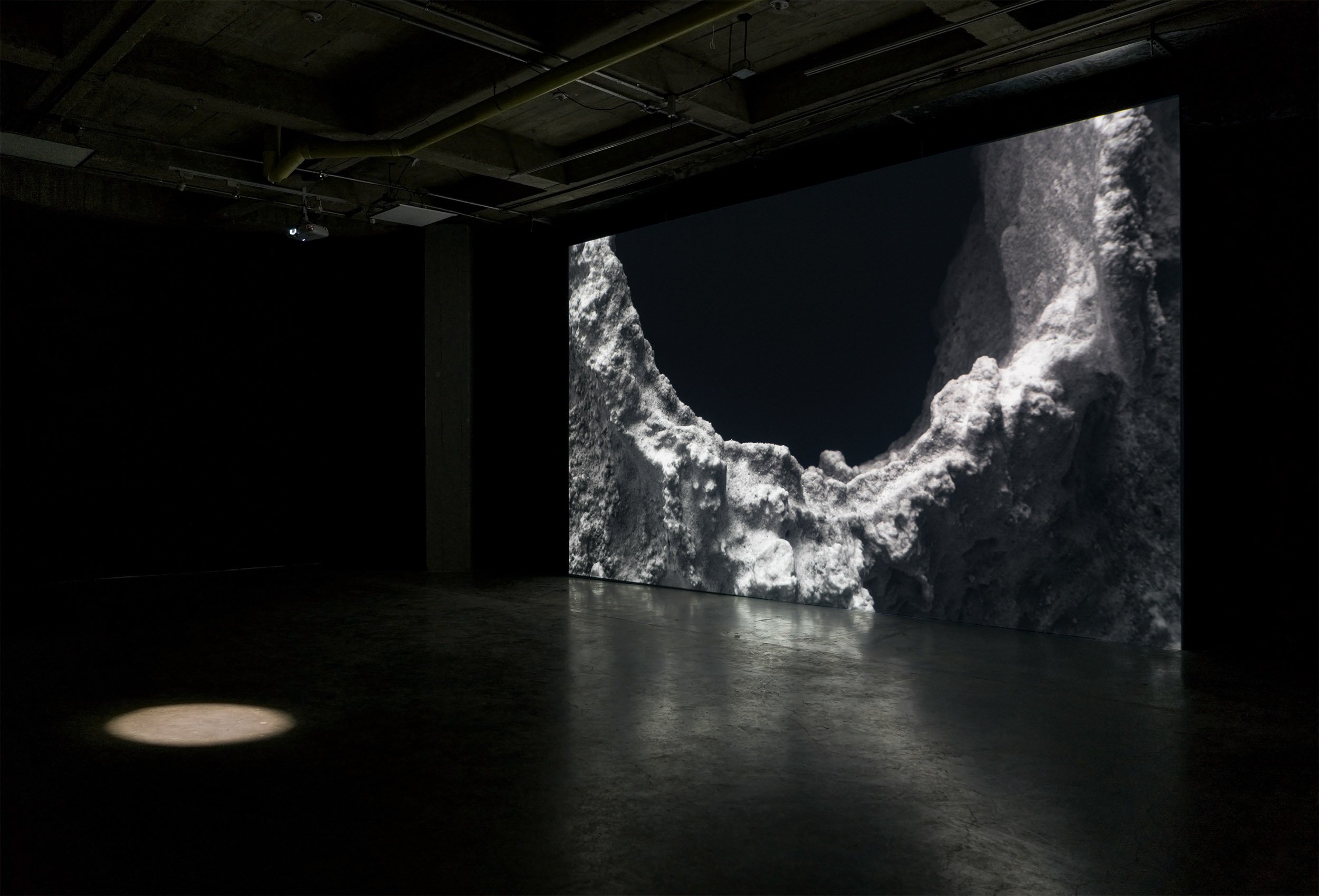El espacio entre las cosas
(The Space Between Things)
2019
Screens: Variable dimensions; Video: 01:03:01 min
Developed with the support of The Sara Modiano Foundation for the Arts
Installation view. Espacio Odeón (Bogotá, Colombia)
Screens: Variable dimensions; Video: 01:03:01 min
Two energy sources drive the Earth. The first one is the Sun, which gives rise to the external processes of the atmosphere, the surface, and the hydrosphere. The second, the Earth’s interior, continues to retain much of the heat produced during the planet’s formation. Moreover, it also generates it, leading to internal dynamics that cause geological formations and events to develop. In fact, both sources share a common origin; 4.6 billion years ago, the star emerged from the same nebula that created Earth’s core. Yet, although human beings have explored outer space, both extremes remain virtually unknown.
Perhaps heat, synonymous with closeness, could be considered a mutual feature, energy in transit connecting two places so distant and inaccessible to us? How to speculate about “that something” which unites and impacts a multiplicity of manifestations but is ungraspable?
This project begins with a trip to camp on the volcanoes Cerro Negro, Chiles (Ecuador), and Cumbal (Colombia), all three located in the Pacific Ring of Fire; one of the most geologically active areas in the world, concentrating the largest number of volcanoes and earthquakes.
Once there, instead of aiming to reach the summit —an action historically considered a heroic feat of human beings who, because of their skills, manage to “conquer” a mountain—, I decide to embrace the journey as a work in itself. To apprehend it as a container of processes, time, and physical effort, with the intention of walking on depths that I can neither see nor touch.
Cumbal volcano (Nariño, Colombia)
Subsequently, looking to equate the “geological dialogue” —of tectonic plates and volcanoes— with human language —the base of a conversation or an exchange of words— and taking into account both as forms of nearness mediated by heat, I propose two collaborations. With Colombian geologist and writer Ignacio Piedrahíta Arroyave, I write a joint text that revolves around the relationship between the Sun and the Center of the Earth and how ideas and particles travel. Likewise, I hold conversations with Japanese composer Miki Yui, who elaborates a sound design based on audio recorded in the volcanoes.
Finally, the project takes the form of a video installation, through which I explore the concept of the abyss —both as a vast chasm as well as an immeasurable and incomprehensible situation— and the experience of being situated between two ends.
Installation view. Museum of Modern Art of Bogotá (Bogotá, Colombia)
On the one hand, two large-format screens face each other, displaying footage recorded during the trip and fragments of the text developed with Piedrahíta —all this accompanied by Yui’s sound composition constantly resonating through the space—.
On the other side, located in the center of the room, a spotlight points towards the floor, constantly suggesting the above and below and inviting the viewer to enter a gray zone, a space of vagueness. The text’s ambiguous tone —as if emulating a thought process— and the abstract fragments of mountains become the medium allowing the visitor to navigate the work. Just as heat does, circulating stealthily, like the space between things.
* Within the exhibition framework, a reading and conversation session takes place in the video installation under the title: ¿Qué hay en la mitad? ¿Un abismo? ¿Un bucle extraño? (What is in the middle, an abyss, a strange loop?). The participants are astrophysicist Jaime Forero, philosopher and book editor Catalina Vargas, artist Nicolás Paris and myself.
Before the meeting, I propose that each of us select a text of any kind that we consider resonates with the show. The first part of the activity unfolds in partial darkness, the only light sources being the central spotlight and the looping videos. Each participant alternately steps forward to a chair under the circle of light, reads the text they have chosen, and briefly comments it with the audience.
Jaime reads a randomly picked excerpt from Raimon Panikkar with the help of the listeners and three antipoems by Nicanor Parra. On the other hand, Catalina shares a text she wrote relating to the video installation and a fragment of the book of Genesis in The Zohar. Then, Nicolás, with his sound piece Viaje doméstico (Domestic Trip) in the background, reads Fernando González’s Viaje a pie (Journey on Foot). Later, for my part, I share philosopher Graham Harman’s The Third Table, which is quoted in the video. Finally, we explore and debate ideas raised by the readings, among us, and with the public.
Click on the images to enlarge:



